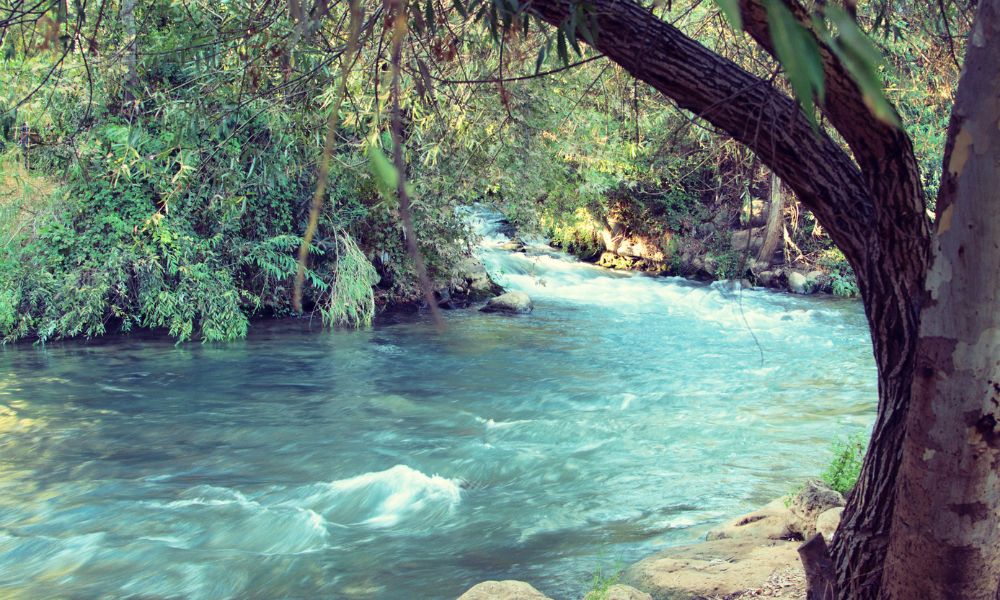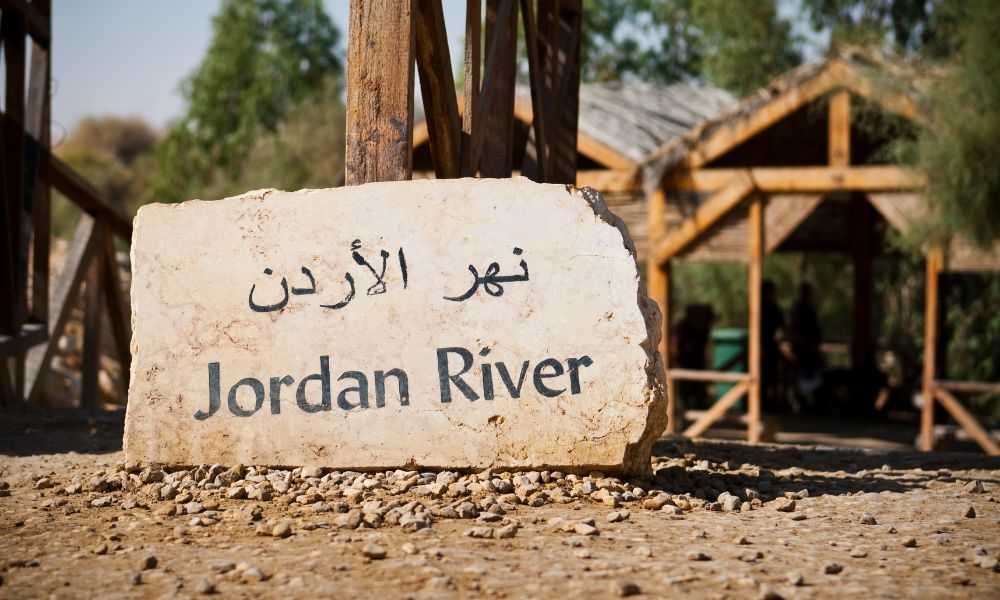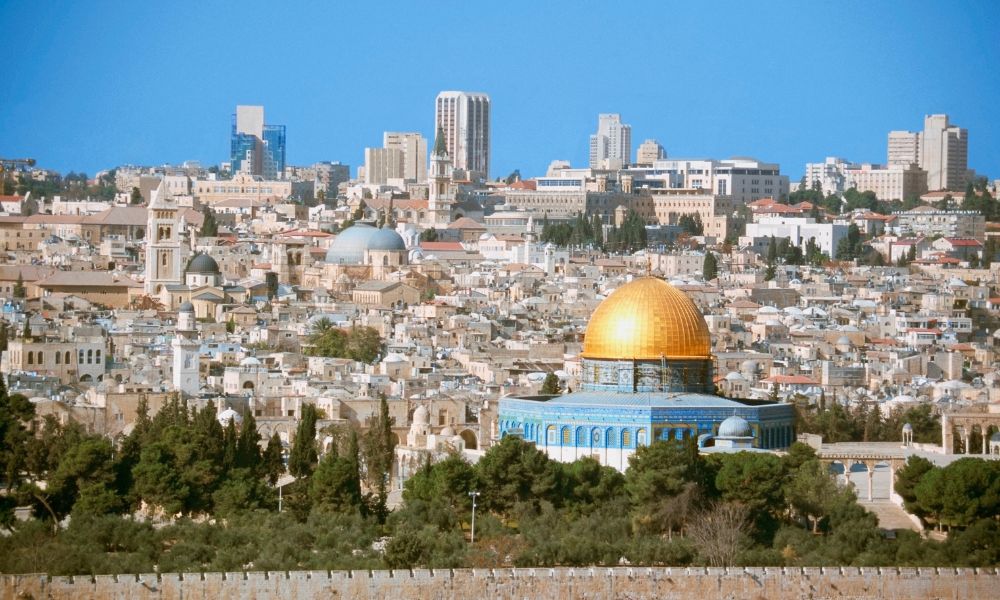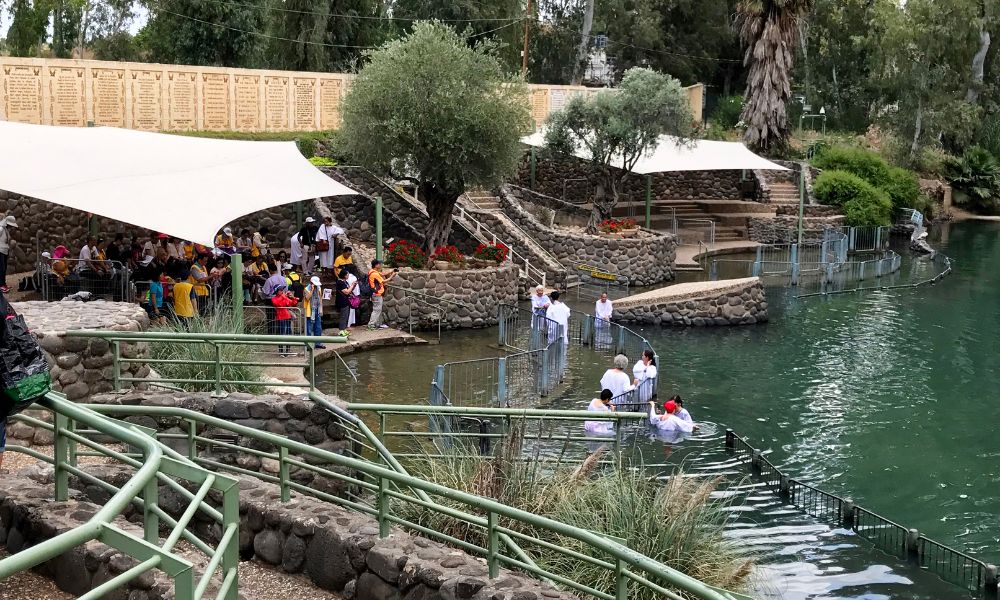Immerse yourself in the spiritual depth and serenity radiating from the waters of the Jordan River, an iconic site echoing the sacred past. This place is not just a body of water in the Middle East but a fundamental pillar in Christian tradition. It is recognized as the scene of Jesus’ baptism, a moment that marked the beginning of his ministry and his revelation to the world.
The baptism of Jesus is not just a biblical account; it is an event that continues to shape faith and religious practice to this day. By exploring the waters where John the Baptist immersed Jesus Christ, we find a unique opportunity to reflect on the profound meaning of baptism: a symbol of purification, rebirth, and new life in the light of Christian faith.
Its importance transcends the anecdotal. It stands as a silent witness to promises and prophecies, a place of pilgrimage that draws believers from all over the world, eager to renew their faith in the same waters that welcomed Jesus.
Join us on a revealing journey that will enrich your spirit and allow you to walk in one of the most revered settings in Christian history.

The site where Jesus was baptized holds immense spiritual importance and has been the focus of fascinating archaeological and historical activity. Over the centuries, this place has been a subject of veneration and study, revealing layers of history intertwined with defining moments of the Christian faith.
In recent years, excavations at the baptism site have shed light on ancient structures and elements that confirm and enrich our understanding of this sacred place. Archaeologists have unearthed remains of ancient churches and baptisteries dating back to the early centuries of Christianity, providing tangible evidence of the early veneration of the site.
Throughout the centuries, this place has been a focal point for pilgrimages to the Holy Land. Historical records and archaeological evidence show a continuous visitation and use of the site, proving its enduring significance.
From ancient mosaics to inscriptions and pilgrim accounts, the site has been and continues to be a living testament to the devotion and faith that draw people to return to this sacred river.
This sacred site holds a central place in biblical narratives, not only as the location of Jesus’ baptism but also as a recurrent setting in both Old and New Testament accounts. From the stories of Elijah and Elisha to the moment when Jesus was baptized by John the Baptist, the Jordan River is mentioned on multiple significant occasions within the Bible.
Each mention carries a profound symbolic weight, representing moments of transition, purification, and divine revelation. Theologically, this moment is viewed as the manifestation of the Trinity, with the Holy Spirit descending in the form of a dove and the voice of the Father expressing his pleasure with his Son.
Water in Christianity is a symbol of purification and spiritual renewal, concepts that are exemplified centrally in baptism. This sacrament represents the cleansing of sin, the death of a sinful life, and the rebirth into a new life in Christ.
Additionally, the waters of the Jordan connect physically and spiritually to sacred places like Jerusalem and the Mount of Olives, expanding its meaning as an element that purifies, sanctifies, and unites the holiest sites of Christianity in an ongoing and living act of faith.

This is one of the most significant locations in Christian tradition. In addition to being the site of Jesus’ baptism, it has also been the setting for several miracles and important events described in the Bible. Below are some of the miracles and extraordinary events associated with this river:
These events and miracles have made the Jordan River a place of pilgrimage and veneration for many believers, symbolizing faith, purification, and divine intervention in human life.
The Jordan River, renowned for its biblical and spiritual significance, faces critical challenges today that threaten its preservation and the surrounding areas. The conservation of this natural resource is vital to maintaining its historical and cultural legacy, as well as ensuring its survival in the face of growing environmental challenges.
Local and international organizations have taken proactive steps to preserve the integrity of the Jordan River. These efforts include ecological restoration projects, sustainable water management programs, and awareness campaigns aimed at educating the public about the importance of this river.
Collaboration between government agencies, environmental groups, and religious communities has been crucial in addressing issues of pollution and habitat degradation. The goal is for the place to continue to be a site of pilgrimage and spiritual reflection.
Climate change has had a profound impact, manifesting in forms such as the reduction of water flow and the alteration of aquatic and terrestrial ecosystems. This situation is exacerbated by excessive water extraction for agriculture and human consumption, which further reduces the natural flow of the river.
In addition, urbanization and industrial development in nearby areas have increased pressure on natural resources, affecting the river and nearby historical and spiritual places such as Gethsemane.
These challenges highlight the urgent need to adopt stricter and more collaborative policies to mitigate the effects of climate change and regulate human activity in the region. In this way, the preservation of these sacred sites is ensured for future generations.
This is a deeply enriching experience, full of history and spirituality. To ensure your visit is as impactful and respectful as possible, we’ve compiled a practical guide that includes the best time to visit, how to get there, and what to expect. Additionally, we will provide tips for a meaningful and respectful visit.
The climate in the Jordan River region varies, but the best times to visit are during spring (March to May) and autumn (September to November). During these months, temperatures are more moderate, and the landscape is at its most vibrant, making the visiting experience more comfortable and aesthetically pleasing.

The Jordan River, a place of profound spiritual and cultural importance, is accessible by road from major cities in Israel and Jordan. Visitors can choose to arrive in their own vehicle, join organized tours, or use public transportation, which offers convenient and affordable routes to the main access points of the river.
Upon arrival, you’ll find a well-equipped area to welcome visitors from around the world. Visitor centers provide essential information, maps, and resources to help you better understand the significance of the place.
Additionally, the resting areas offer a space for reflection and repose, and well-maintained trails guide you through panoramic views and points of historical and spiritual interest.
It’s essential that visitors arrive with an understanding of what this sacred river represents. Although the area has been adapted for tourism, it retains an air of solemnity and peace that is expected to be respected by all who visit.

During major holidays such as Easter, the site also hosts special celebrations that draw pilgrims from around the world.
These activities are designed to deepen the understanding and appreciation of the Jordan River. They allow visitors to take away both memories and a greater understanding of its spiritual and cultural significance.
The Jordan River, recognized both for its religious significance and its historical value, faces a promising future full of projects and collaborations aimed at its conservation and enhancement. These efforts seek to preserve the integrity of the site and improve the experience for visitors from all over the world.
Below are some of the future projects and international collaboration initiatives underway to promote and protect this sacred place.
Future plans for the baptism site include expanding and renovating existing infrastructure, such as visitor centers and sanitary facilities, to better accommodate the growing number of visitors.
In addition, projects are being developed to improve trails and signage, ensuring they are accessible to all, including people with reduced mobility.
Another important aspect of future developments is the incorporation of green technologies to minimize the environmental impact of tourist activities. For example, greater use of solar energy to power site facilities and more efficient water management systems.
Recognizing the global importance of the Jordan River and its baptism site, several international organizations, including UNESCO and numerous NGOs focused on heritage conservation, are collaborating with local governments to promote and protect this historic site.
These collaborations include cultural and scientific exchange programs, aimed at sharing knowledge and experiences regarding the preservation of similar sacred sites around the world.
Additionally, joint tourism marketing initiatives are being launched to highlight the site’s importance within the global pilgrimage route, connecting the baptism site with other sacred places in the region and beyond. These campaigns aim not only to increase visitor numbers but also to educate the global public about the rich history and spiritual significance of the Jordan River.
Through these combined efforts of sustainable development and international cooperation, the future of the baptism site at the Jordan River looks robust and full of potential.
Stay Connected with WayHoly
Discover your perfect pilgrimage and be the first to know about new journeys. By subscribing to our newsletter, you’ll receive the latest updates on pilgrimages, exclusive offers, and spiritual resources to enrich your faith journey.
Don’t miss the opportunity to deepen your connection with God and lead others on their path to spiritual renewal. Join us today and become an instrument of His Will through WayHoly!
“To upload your pilgrimage, please choose one of our plans and create an account, or log in if you’re already a member. Join us in guiding others on their spiritual journey.”